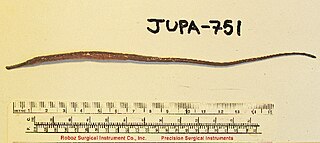
Syngnathus is a genus of fish in the family Syngnathidae found in marine, brackish and sometimes fresh waters of the Atlantic, Indian and Pacific Ocean. Fossils of these species are found from the Oligocene to the Pleistocene. They are known from various localities of Greece, Italy, Germany and United States.
The longsnout pipefish is a pipefish of the family Syngnathidae. It has only been recorded from midwater and bottom trawls at depths of 37–212 metres (121–696 ft). The habitat and biology of this species are almost unknown but juveniles have been recorded in the stomachs of blue penguins and Snares penguins.

The greater pipefish is a pipefish of the family Syngnathidae. It is a seawater fish and the type species of the genus Syngnathus.

The black-striped pipefish is a species of fish in the family Syngnathidae. It is found in the eastern Atlantic from the southern Gulf of Biscay to Gibraltar, also in the Mediterranean and Black Seas. As the introduced species it is mentioned in the Caspian Sea and fresh waters of its basin.

The estuarine pipefish or river pipefish is a species of fish in the family Syngnathidae. It is endemic to South Africa and has been sporadically recorded in the estuarine portions of the Kariega, Kasouga, Bushmans, East Kleinemonde and West Kleinemonde rivers. It can be readily distinguished from another southern African pipefish with which it shares its habitat, S. temminckii, by its much shorter snout. The estuarine pipefish is most commonly found in beds of the eelgrass Zostera capensis.

Darkflank pipefish is a pipefish species which inhabits the north-western Adriatic. It is found both in marine and brackish habitats. It is a demersal fish in which the males are ovoviviparous. It grows up to 19 centimetres (7.5 in) in length. It is found mostly amongst detritus or vegetation on the shallow muddy bottom.

Narrow-snouted pipefish is a pipefish species which inhabits the Mediterranean basin: Adriatic Sea, Tyrrhenian Sea, and Black Sea. It is a marine demersal fish with an ovoviviparous breeding pattern.
Thickly snouted pipefish, Syngnathus variegatus, is a pipefish species which inhabits the Black Sea and Sea of Azov. It is a marine, demersal, ovoviviparous fish.
Pelagic pipefish, Syngnathus phlegon, is a pipefish species of the family Syngnathidae.

The Pacific seaweed pipefish is a species of pipefish, found in the north-western Pacific Ocean, near Vladivostok (Russia), southern to Gulf of Tonkin. It is a marine, oceanic demersal fish, up to 30 centimetres (12 in) length. It is common in beds of Zostera sea grass.

The northern pipefish is a northwest Atlantic species of fish belonging to the family Syngnathidae.
The barred pipefish is a species of the pipefishes, widespread in the eastern pacific from the Southern California, United States, to northern Peru. Marine / brackishwater subtropical demersal fish, up to 18.0 cm length.
Syngnathus carinatus is a species of the pipefish, which is endemic of the northern part of the Gulf of California. It is a marine / freshwater subtropical demersal fish, which grows up to 23 centimetres (9.1 in) length.

The southern pipefish is a pipefish species that inhabits the Southwest Atlantic near Uruguay. It is a marine subtropical demersal fish. This species has been recorded among beds of Ruppia maritima in the Lagoa dos Patos in southern Brazil, and apparently they spend the whole of their lives in sea grass beds. It is a carnivorous species which feeds mainly on copepods and isopods, although the females consume a wider variety of prey. It is an ovoviviparous fish, in which the males bear the fertilised eggs inside a brood pouch located beneath its tail. During the breeding season they are sexually dimorphic which indicates that the species is probably polygamous.
Guadalupe pipefish, Syngnathus insulae, is a pipefish species, inhabits the Eastern Central Pacific, endemic to Guadalupe Island in Mexico. Marine subtropical demersal fish, up to 20.4 centimetres (8.0 in) length.
The bull pipefish is a pipefish species of the western Atlantic, from southern Canada to Panama. It is a marine subtropical reef-associated fish, up to 38 centimetres (15 in) length.
Syngnathus macrophthalmus is a pipefish species, found only around Suez and Hurghada in the northwestern Red Sea. It is a marine tropical demersal fish, up to 12.2 centimetres (4.8 in) total length.

The kelp pipefish is a species of the pipefish. It inhabits the eastern Pacific from the Bodega Bay in northern California, United States, to southern Baja California, Mexico. It is a marine subtropical demersal fish, up to 50 centimetres (20 in) length.
Chocolate pipefish, Syngnathus euchrous, is a species of the pipefishes. Widespread in the Eastern Pacific from Redondo Beach in southern California, United States, to central Baja California, Mexico. Marine subtropical demersal fish, up to 25 cm length.
Barcheek pipefish, Syngnathus exilis, is a species of the pipefishes. Widespread in the Eastern Pacific from the Half Moon Bay in central California, United States, to south central Baja California and Guadalupe Island, Mexico. Marine subtropical demersal fish, up to 25 cm length.









